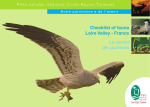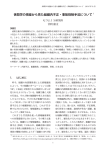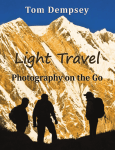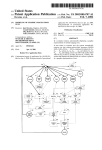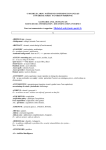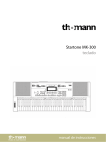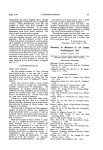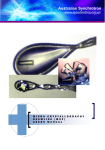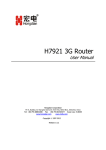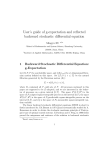Download R01 User Guide NatRevision 20120716 Vol10
Transcript
The Historical Ornithology of Shropshire User Guide Vw05 of 20130211 (BB revised) Introduction The following describes the composition and use of the database as a whole and the Species Index in particular. Some of the published material presented on this website may be regarded by some researchers as being of very low value. However the database attempts to be comprehensive and lists and indexes every known published work (over 4,700 pages from more than 220 works); it is left to individual researchers to make the value judgments. It is all here – use what you need. This User Guide is in four sections: A B C D E the use of the on-line database the Species Index the ten-volume printout version Additional Resources Gallery References, Appendices: Index to authorities, Problem species and other issues A. The Historical Ornithology of Shropshire on-line If you are already looking at the website please go to bullet point three below: • Start (a) at the Shropshire Ornithological Society’s (SOS) website, (b) enter this web-site address into the address-bar in your web-browser http://www.shropshirebirds.com/. • From the SOS website right-click on ‘The Historical Ornithology of Shropshire’ among the bulleted options and it will take you to the ‘Historical’ website. • The black band under the landscape photograph contains a number of ‘drop-down menus’. Hover the curser over ‘The Historical Record’ and a drop-down appears. • Click on the option ‘All historical documents’ and they will be listed down the screen. • Every source is listed, in chronological order from 1836, most with a green View button. • Scroll down to the year and document you want, click on its button and the contents will appear as a list of page-numbers each with a short text, the first-listed species name for pages within systematic lists. • Hover the cursor over the page you want (the grey View button will turn red) and the text will appear (give it time). • Some lists are rather long and if you roll over to a selection near the bottom of the list the page may appear at the top of the page – you will need to scroll up the document to see the page you requested, a process much easier by ‘swiping’ on an iPad. • If you want to save a page then ‘right-click’ somewhere on it and the box will appear within which choose “Save image as ...” which will enable you to save the page where you want on your own computer. • In the top right-hand corner is a window over ‘Search this site”. It will find text occurring within the website but note that it does not search within the pages of the documents. There are five blue Link buttons on the ‘All historical documents’ drop-down; they are short-cuts to expanded parts of the total list and each one presents a list in chronological order. They are 1 2 3 4 5 J. Rocke’s four papers in Zoologist of 1865 and 1866 W.E. Beckwith’s entire canon of between 1878 and 1893 Caradoc and Severn Valley Field Club annual Record of Bare Facts, 1892 to 1960 Caradoc and Severn Valley Field Club more or less annual Transactions, 1893 to 1960 Annual Bird Reports (ABR) of the Shropshire Ornithological Society, 1956 to the most recently published. Note that up to 1999 the format is as described above but from 2000 onwards they are PDF files. All published ABRs are Species Indexed. B. The Species Index 1 The Species Index is comprised of two PDF files: Species Index, alphabetically in International English Name order IOC-BOURC’s Systematic List, from Gill & Donsker (2010) The Species Index, comprised of over 10,400 entries The BOURC’s Systematic List file gives the International English Names (col. A) with two alternative scientific names (Ibis (1923)) (cols. C&D) and sequential numbers imposed by the editor of this work (col. B). This list can be used to find species by their scientific names. Species without entries in this PDF file carry their binomials within their first Species Index entry. See 2.1 below for instructions on how to find entries in PDF files. 2 The Index The five Columns are named at the top of the file; for 1, 2 & 3 see 2.10 below. 2.1 Col. 4. International English Name Species are listed alphabetically in International English Name (IEN) order. To find entries in the two PDF files: (a) click anywhere within the file you are looking at (b) hold down the CTRL key and then type an ‘F’ (on the Mac the CMD key and type ‘F’) (c) this opens a new PDF search window top right (not to be confused with the very top right Internet search window) (d) enter the characters to search for into the PDF search window and type a RETURN (e) the screen will display the characters you requested. To help find species using their more usual common names these have been added within the cell containing the first entry for each species. Thus for example using the ‘find’ feature (top right in the PDF file) ‘Wood Lark’ or ‘Woodlark’ will both return the official IEN ‘Wood Lark’ and searching for ‘Dunnock’ or ‘Hedge Sparrow’ both take you to the official IEN ‘Hedge Accentor’. In this column under ‘People’ are a number of obituaries and other notes about the people involved in the publications. The list is not exhaustive and the interested reader is directed to for example Forrest (1899) The Fauna of Shropshire, Chapter 2, Shropshire Naturalists pp.17- 31 (not on this website). 2.2 Col. 5. Cons Species consecutive numbers within the systematic list of Gill & Donsker (2010), imposed by the author of this work. 2.3 Col. 6. Reference Every species has every meaningful reference indexed up to and including 31.12.1955, after which the SOS Annual Bird Reports commence. See also 2.8 and 2.9 below. References are given in chronological order in the form Year : authority : page/s * These data will take the user to the relevant work in the database. Details for citations appear within the ‘All Historical documents’ drop-down menu and in Additional Resources – Citations List. A few ‘Reference’ cells are highlighted dark green where they appear to feature the first records for the county though they must not be regarded as definitive. An index to authorities is given as Appendix 1 below. 2.4 Col. 7. Name in text This contains species names as they appear in the referenced work, included especially for early references which use arcane names and is not wholly reliable in two respects. First, for example, the early use of the name Aberdevine in 1837 may refer to Eurasian Siskin but might also be to a redpoll. Second, the process of creating the index involved the frequent copying of existing records into new rows and previously used names were thus carried forward into new rows, in error. Researchers interested in old Shropshire names should see for example Forrest, H.E. (1909) pp.75-82 Shropshire names for birds and beast – CSVFC Transactions. 2.5 Col 8. Notes This cell contains occasional comments, includes incidental notes of interest to the author and is therefore highly selective. Of real significance within Notes are references in UPPER CASE RED text to published errors, omissions, corrections and for example formal Records Committee rejections and acceptances of rarities. These can otherwise all too easily be lost or overlooked. 2.6 Species with their text in blue are introductions, escapes, aliens or exotics. Latterly these are listed in SOS ABRs at the end of reports under, variously, ‘Escapes and Feral’, see 2.10. However some undoubted exotics (eg. Mandarin) are in the BOURC list and generally in the main texts of SOS ABRs. They are blue in this work because they are regarded as naturalised, ‘breeding freely in the wild’. 2.7 Index entries with text in red are generally records from just outside Shropshire included for clarity; some have been previously claimed for the county and others remain in some doubt, for example the first county Spotted Redshank on the Cheshire border. Or they may be records formally rejected by Rarities Committees, cited in the Notes cell. 2.8 Species with their initial common name cell highlighted in green are those for which every known record is indexed. They are the less frequently recorded species and include all those on lists of species requiring descriptions for formal consideration by Rarities Committees. Around 48% of all index categories (not all are full species) are fully indexed in this way. 2.9 Species with their initial common name cell highlighted in yellow are those for which every known record is indexed outwith the Annual Bird Reports of the SOS. This is because in general terms they can be assumed to have more or less annual ABR statements which the serious researcher will need to examine individually and for which indexed entries would be of little help. 2.10 Columns 1, 2 and 3 may carry a ‘1’, equivalent to a ‘tick’ but the 1 here is used here as a counting device as follows: In Column 1 (yellow) for indexed species accepted to the Shropshire List (n=302) In Column 2 (blue) for indexed introduced/exotic and/or alien species (n=44) In Column 3 (green) for every indexed species notes in the county (n=346) A dash (-) is used for outwith-Shropshire, for rejected records and for sub-species (n=8). 2.11 Museum materials listed at ‘Additional Resources – Museums’ are Species Indexed BTO ringing data at ‘Additional Resources – BTO Ringing data’ are not Species Indexed. 3. The future 3.1 The author will be pleased to hear of additional Shropshire material which will, wherever possible, be added to the database; it is in all our interests that it remains comprehensive. 3.2 Work is under way to Species Index mentions of Shropshire in Articles and Reviews throughout British Birds (BB), see Part F. 3.3 In time there will be additional lists of informally published local project reports. 3.4 If you would like to work with a paper copy of Historical there is an SOS printout for study. It is comprised of nine lever-arch files of A4 printout. I suspect that I will remain the custodian of the SOS copy so let me know if you would like to borrow it. There is no printout of the Species Index, a printout of the 10,700 or so rows would run to over 270 pages and it must be used in e-form, which is in any case by far the quickest way to search it. 3.5 Please report any errors or omissions in the database; they will be corrected. 3.6 Offers are invited to compile a Sites Index. 4. Researchers The Excel spreadsheet version of the Species Index, easier to search and manipulate in detailed searches, is available on request to the author – see Contact. C. The nine-volume printout version There are two copies of the printout version. One is held by the author in Aston on Clun and used for indexing, general administration and personal research; it is annotated with the indexing and other notes and it will ultimately transfer to the SOS. The second copy is in the hands of the Shropshire Ornithological Society; it is likely to reside with the author and is available for loan for research use. The printed works are arranged in chronological order as is the on-line version. Each document is give a sequential number, 1 to 72 at 22.02.2012. Within this system all CSVFC annual Record of Bare Facts/Recorders’ Reports are within number 23 all CSVFC Transactions are within number 24 and all SOS Annual Bird Reports are within number 45. At Additional Resources – Citations List is a catalogue of all 70+ works which can be used to derive citation details, also given in brief in the on-line version along with acknowledgements to their sources. The nine volumes contain the following: Volume 1. Documents 1-27. Everything from 1836 up and including 1899 with the exception of the works of WE Beckwith which are in Volume 2 Volume 2. Documents 8 to 21, being everything by WE Beckwith (1878 to 1893) Volume 3. Record of Bare Facts of the Caradoc and Severn Valley Field Club, 1892 to 1925 Volume 4. Record of Bare Facts of the Caradoc and Severn Valley Field Club, 1926 to 1960 Volume 5. Transactions of the Caradoc and Severn Valley Field Club, 1893 to 1960 Volume 6. Documents 28 to 71, being everything from 1900 to 1999 except the Annual Bird Reports of the Shropshire Ornithological Society, which occupy Volumes 7, 8 & 9 Volume 7. Annual Bird Reports of the Shropshire Ornithological Society, 1956 to 1980/81 Volume 8. Annual Bird Reports of the Shropshire Ornithological Society, 1982 to 1992 Volume 9. Annual Bird Reports of the Shropshire Ornithological Society, 1993 to 1999 Volume 10. SOS Annual Reports 1999, papers 1998 ownards The Annual Bird Reports of the Shropshire Ornithological Society for 2000 and later are available online as PDF files. All will be indexed in updated versions of the Species Index. D. Additional Resources This drop-down gives access to a variety of useful material. First, ‘Historical Resources’ leads to the following, all of which relate directly to this data set 1. User Guide and explanatory text. 2. Species Index, for explanatory text see Section B here 3. Citations List and explanatory text. 4. Author Index and explanatory text 5. Gazetteer of Shropshire place-names 6. Key maps to Shropshire cover by OS maps at 1:50,000 and 1:25,000 7. Regisiter of Research Interests discontinued; please see the SOS website at Research Projects and Reports; http://www.shropshirebirds.com/research.htm ‘BTO Ringing Data’ gives links to three British Trust for Ornithology websites listing ringing totals and selected recoveries. The BTO is thanked for permission to use these links. Ringing records are not indexed in this website’s Species Index. ‘Museums’ currently links to the bird collections of the Birmingham Museum and Art Gallery, a six-part series of PDF files listing skin and egg collections. Museum material from Shropshire is included in the Species Index. There are two texts covering Acknowledgements and Copyright. E. Gallery This features a dozen or so images principally likenesses of the county’s early writers. F. British Birds references to Shropshire. F1. Introduction. In relation to this Shropshire-oriented ‘Historical’ website British Birds is a primary source because of its papers on rare breeding birds and national rarities. Both topics are the subject of committees publishing definitive annual reports which include occasional references to Shropshire. Further, from time to time papers appear which relate specifically to Shropshire or include references to the birds of the county. All meaningful BB references to birds in Shropshire are indexed in this website’s Species Index. The following explains how they are indexed. F2.1 British Birds references to 2007: British Birds began publication in 1907 and the first 100 years, to 2007, are freely available online on the BB website; see below for how to access them. Access to particular material on the BB website is possible via the volume and pages numbers of the paper involved and these data are provided in the Species Index to this website. Thus this website makes Shropshire references in BB, to 2007, available by providing that key information. For example Black-eared Wheatear. In Historical’s Species Index, in the ‘Reference’ column, appears “1989: BB 82(11):505-563”, sufficient to locate the paper on the BB website (volume 82, pages 505-563). In the ‘Notes’ column of the Species Index appears “p.562. Chelmarsh 23-24.5 REJECTED”, taking you to the relevant page in the paper and adding a brief note. In this case the entire Index entry is in red drawing attention to the fact, in this case, that the record was rejected by the Rarities Committee. F2.2 British Birds references 2008 onwards: BB material from 2008 onwards appears on this website based on individual years. In the ‘Historical’ drop-down “The ‘Historical Record>All historical documents” BB volumes (all issues) appear annually in chronological order. Progressing, placing the cursor over the green, View button the relevant, indexed Shropshire pages appear in order. Full papers relating to the county, eg. “Magnificent Frigatebird in Shropshire - new to Britain” appear chronologically as individual items within ‘All historical documents’ but not until three years after their publication, at the request of BB. For these, within the three years, you will have to consult an original paper copy. Access to the indexed British Birds material, via the BB website, is as follows. 1. Register at the BB website; it is free and you need to do this only once. Go to the BB website http://www.britishbirds.co.uk/ Click on ‘Register’ top right and you will see the registration page. You do not have to be a subscriber to BB in order to register so you may leave part 3 blank and just complete parts 1 and 2. Remember your password, tick Terms and Conditions and click on ‘Register’ at the bottom of the form. 2. Species Index entries to BB materials are given as in this example for Red-backed Shrike: 1990: BB 83(9):353-390 and in the Notes field ‘See p.385’ giving the Year: BB Volume(Issue):page-range. Make a note of the Volume and page-range, here 83 and 353 to 390 and the page of the Red-backed Shrike reference, here 385. To access the reference by search of the BB site: 3. To initiate a search for the exemplar Red-backed Shrike above go to BB’s home page and click on ‘Article archive search’, top right, and it will take you to an Article Search form. At the bottom of the form you need only enter only the Volume and page-range data, namely 83, 353 and 390 and click on ‘Search’ to bring up the article. Double-click on the article title to bring up the page offering ‘Click here to download the full article’. Then click on ‘Click here to download the full article’ for the PDF. Now scroll down to page 385 for the Red-backed Shrike data. 4. To search the article for other data within it hold down the CRTL key and type an ‘F’ to open the PDF ‘find’ window (top right) and enter your search text into that window and click on ‘Done’. You can then use the left and right arrows to scroll through the pages found with your search text. 5. It is possible to print pages, ‘copy and paste’ sections and to word-search the document (using the CTRL with ‘F’, or CMD with ‘F’ on the Mac) as required. Acknowledgements The SOS kindly gave a small grant to cover the costs of the project. Much of the material in this resource (77% of pages) comes from either the periodicals of the Caradoc and Severn Valley Field Club (CSVFC), its predecessor the Shropshire Natural History and Philosophical Society (SNHPS) or the Shropshire Ornithological Society (SOS) for whom it has been compiled. The SNHPS no longer exists and the CSVFC kindly gave permission for their material to us used. A full copy of the CSVFC papers is kept at the Shropshire Archive in Shrewsbury and was photographed by the editor using facilities kindly made available by the Conservator Andrew Davidson. The Shropshire Archive was also the source of several other works used here. Acknowledgements are given to sources in their website entries.. All are thanked for their valuable help and permissions. Several individuals have been particularly helpful during the year 16 months it has taken to compile and make the material available. My brother Peter, joint author, has been entirely responsible, also as a volunteer, for the design and creation of the website. Without Peter’s tireless and patient work the material would lie only within the nine-volume printout on my shelves and in my own computer. This website is a monument to his design skills and dedication. Colin Wright, one-time editor of the SOS Annual Bird Report, has been an ardent supporter of the project over the 20 years or so that we have discussed it. Simon Holloway has given his support, often finding obscure publications on the internet and Tom Wall has put me onto several local history books including the first-hand account of collecting Lapwing eggs for Fortnum and Mason in the 1930s. Patricia Francis, current editor of The North-Western Naturalist (TNWN) and Natural History Curator & Exhibitions Co-ordinator at Gallery Oldham kindly searched and provided copies of Shropshire material from TNWN. Gallery Oldham kindly gave permission for the reproduction of the painting of the taxidermist’s workshop by John Houghthon Hague (1842-1934) http://www.galleryoldham.org.uk. Several of the above and others have helped with additional material, proof-reading and checking; any errors which remain are my own. I must also thank the many people who between them compiled the Shropshire Gazetteer as volunteers for Shropshire Wildlife Trust in the late 1980s and early 1990s. References Gill, F. & Donsker, D. WorldBirdNames A website at http://www.worldbirdnames.org/ Ibis 65(3):424-435 (1923) XXVII Report of the Committee on the Nomenclature and Records of Occurrences of rare Birds in the British Islands and certain necessary Changes in the Nomenclature of the B.O.U. List of British Birds. Appendix 1 Index to the abbreviations used for authorities as cited in Column 6 (Reference) of the Species Index. Beckwith, WE various years Paddock, GH various years Tuer, B one paper and other authors in similar format Forrest, HE Rocke, J Yapp, WB various years various years one paper BMAG Birmingham Museum and Art Gallery collections of skins indexed as “year: SKIN BMAGn: pages” where n is the number of the text ‘Part’ available at http://www.lanius.org.uk/sos/sos-museums.html or as EGG (in place of SKIN) in the case of eggs, all of which are in BMAG6. BullSNU Bulletin of the Shropshire Naturalists’ Union (one volume only, 1995) CSVFC RBF Caradoc and Severn Valley Field Club, annual Record of Bare Facts (latterly Recorder’s Reports) 1892-1960 Annual reports contain records from the same year. CSVFC Trans Caradoc and Severn Valley Field Club, annual Transactions 1893-1960 Year reports, usually called Zoology Reports, present records from the previous year. NOTE. Transactions were not published every year and the following combined volumes (here as years) appear in references named by their start years: 1943-44 indexed to as 1943 1945-46 indexed to as 1945 1947-50 indexed to as 1947 1951-56 indexed to as 1951 1957-60 indexed to as 1957 Handl SOS A Handlist of the birds of Shropshire (1964) SN Shropshire Naturalist 1992 and 1993 (only) SOS ABR Shropshire Ornithological Society Annual Bird Reports NB. Annual reports contain bird records of that year. SSOS/SONHS Shrewsbury School – Ornithological Society or Natural History Society NWNat The North Western Naturalists’ Union Bulletins Appendix 2 Problem species and other issues. Redpolls and White/Pied Wagtails are potential problems: A plethora of common/ lesser/ mealy/ redpoll/ redpole references are recorded under a range of names in columns 4,7 and the notes in 8 and serious students of these groups are left to sort them out. Pied Wagtail now has the International English Name White Wagtail and, once again, the student of these two is left to sort them out. Clarifications for both the above will be welcomed as amendments to the index.







